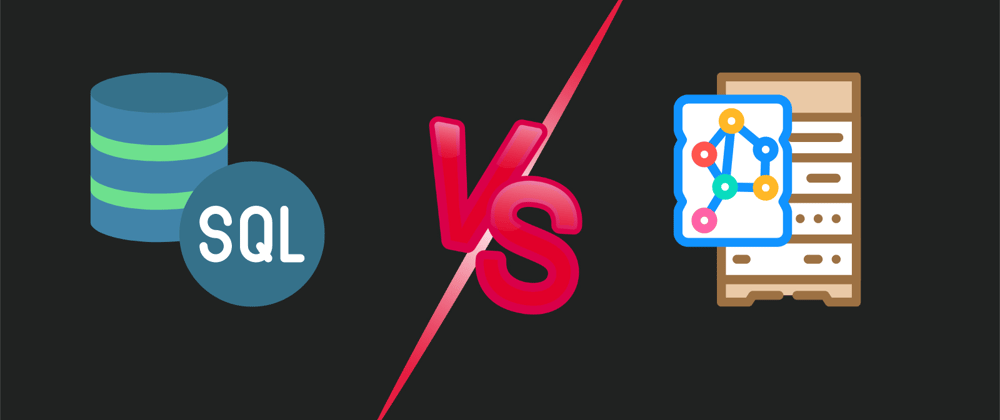The debate between SQL vs NoSQL databases has been going on for a couple of years. However, databases are the backbone of any application, storing, managing, and retrieving data efficiently.
SQL has been the go-to choice for data handling for decades. In contrast, NoSQL emerged to address the growing needs for scalability, flexibility, and various data structures that traditional SQL databases struggled with.
The goal of this blog post is to break down the differences between SQL and NoSQL databases so that you can figure out which one might work better for you.
What is SQL?
SQL databases are the traditional way of managing data. As relational databases, they use a methodical, table-centric format to organize and store data.
We use fixed type of schema to manage data, such types of databases. Where each table consists of rows and columns; rows denote each record, and columns signify unique attributes of these records.
This type of structured schema is pivotal in maintaining data integrity, as it enforces consistency in data types and relationships and also for executing complex queries and managing complex transactions, ensuring that the data retrieved are both accurate and reliable.
A unique feature of SQL databases is their ACID properties: — Atomicity, Consistency, Isolation, Durability. These properties ensure the transactional integrity of the SQL databases.
Atomicity ensures transactions as indivisible units, completing either all operations successfully or applying none. This guarantees that the database remains in a consistent state in case of a failure during a transaction.
Consistency ensures that each transaction brings the database from one valid state to another, maintaining the predefined rules and constraints of the database.
Isolation defines how the interaction of concurrent transactions affects transaction integrity visibly. It ensures that transactions occurring simultaneously do not affect each other’s execution paths.
Durability guarantees that a committed transaction will remain intact even in the event of a system failure. This ensures the permanence of the database’s state.
Because of these ACID properties, SQL databases are exceptionally reliable. Therefore, they are the best choice in places where consistency and reliability are very important.
For example, SQL databases are very useful in banking and financial systems that must ensure the accuracy of transactions and the security of data.
Their strong transactional integrity and ability to handle complicated queries and transactions quickly make them a solid foundation in structured data management.
What is NoSQL?
NoSQL databases are a significant change in database technology. Initially, developers consider NoSQL databases to overcome the challenges of SQL databases. These limitations primarily concern scalability and flexibility.
NoSQL, standing for Not Only SQL, differs from the traditional relational database structure. It works with a lot of different data, which differs from SQL’s rigid, table-based framework.
Types of NoSQL Databases
Key-Value Stores: Simple yet powerful, these databases function like dictionaries, associating unique keys with specific values. They are ideal for scenarios where quick access to data is a priority.
Wide-Column Stores: Organizing data into columns rather than rows, these databases excel in handling large datasets, allowing for efficient data storage and retrieval.
Document-Based Databases: These databases store data in document formats, like JSON or XML, making them suitable for managing semi-structured or unstructured data.
Graph Databases: Focused on managing data with complex relationships, graph databases are particularly useful for network analysis, such as in social media or recommendation systems.
Characteristics of NoSQL databases
A fundamental characteristic of NoSQL databases is that they don’t have a fixed schema.
Because the database can hold unstructured and semi-structured data such as JSON, XML, and others without requiring a specified schema, it enables more dynamic and flexible development processes.
This is especially useful when the data model is likely to grow over time or when the data does not fit neatly into tables.
When creating NoSQL databases, developers build them with distributed data stores in mind.
This design philosophy inherently addresses the challenges of scalability and reliability in handling massive volumes of data and accommodating high user loads.
As a result, NoSQL databases are typically highly scalable, allowing them to expand dynamically to meet the growing data and traffic needs of today’s applications.
However, NoSQL databases often operate on the BASE (Basically Available, Soft state, Eventual consistency) model.
The ACID properties of the SQL databases differ from this approach. While BASE focuses on availability and partition tolerance, it doesn’t follow the strict consistency of ACID.
In a BASE system, data is basically available, so the system mainly focuses on ensuring the availability of the data.
Because of the final consistency model, the system’s state can change over time, even with no additions, because of its “soft state” nature.
This model ensures the database will eventually achieve consistency, allowing for temporary inconsistencies during this period.
In addition, this approach offers greater flexibility and scalability compared to the rigid consistency model of ACID, making NoSQL databases particularly suited for applications where immediate consistency is not critical.
Comparative Analysis: NoSQL vs SQL
The choice between NoSQL and SQL databases often depends on the specific requirements and constraints of a project.
Comparative Analysis: NoSQL vs SQL
The choice between NoSQL and SQL databases often depends on the specific requirements and constraints of a project.
| Comparative Factor | SQL Databases | NoSQL Databases |
|---|---|---|
| Data Structure | Structured, table-based format with a rigid schema. | Various types of structures: key-value, document, wide-column, and graph. Handles unstructured or semi-structured data without a fixed schema. |
| Scalability | Often vertically scalable (enhancing server capacity). Vertical scaling has limits. | Designed for horizontal scalability (across multiple servers or nodes), adept at handling large data volumes and high loads. |
| Flexibility | Rigid schemas make them less adaptable to changes; modifications often require downtime. | Schema-less nature provides greater flexibility for modifications and data model evolution. |
| Complexity and Ease of Use | Standardized, declarative query language; complex queries can be challenging. | Varies by type; document databases have simpler queries, while others, like graph databases, have a learning curve. |
| Consistency and Reliability | Follow ACID properties, offering strong consistency and reliability, crucial for transactional integrity. | Typically adhere to the BASE model, offering eventual consistency suitable where immediate consistency is not critical. |
| Performance | More performant for complex queries and relationships. | Better performance for large volumes of simple read/write operations, especially with unstructured data. |
| Advantages | Strong consistency and complex query support, ideal for transactional systems and applications requiring data integrity. | High scalability and flexible data handling, suitable for big data applications and real-time web apps. |
| Limitations | Less flexible in handling schema changes, not as scalable for massive data volumes. | Lack of standardization, eventual consistency may not suit all transactional applications, less efficient for complex queries. |
| Use Cases | Ideal for transactional systems, complex query requirements, structured data applications, data integrity critical systems. | Suitable for big data applications, rapidly changing data models, high traffic web applications, real-time analytics and personalization. |
| Examples | Financial Services, Retail and E-commerce, Healthcare Systems. | Social Media Platforms, E-commerce Personalization, IoT Applications. |
Questions to Ask to Determine the Best Fit for Your Needs
1. What is the structure and complexity of the data you need to store?
Are you dealing with highly structured data or a mix of unstructured and semi-structured data?
2. How critical are transactional integrity and consistency in your application?
Does your application require strong consistency and atomic transactions?
3. What are your scalability requirements?
Do you expect your data to grow quickly or need to handle large spikes in traffic?
4. What kind of queries will you be running?
Do you need to run complex, multi-table joins, or are your queries relatively straightforward?
5. How frequently will your data schema change?
Do you need the flexibility to change the data schema without downtime?
6. What is your team’s expertise?
Does your team have more experience with SQL or NoSQL databases, or are they capable of learning a new type of technology?
7. What is your budget for database management and maintenance?
Consider both the monetary and human resource costs associated with the database.
Common Misconceptions about SQL vs NoSQL Databases
There are several myths and misconceptions surrounding SQL vs NoSQL databases. Making these clear can help you make the best choices:
| Misconception | Myth | Reality |
|---|---|---|
| SQL is Outdated | SQL databases are old and outdated. | These databases are continuously getting better with new features and capabilities, remaining highly relevant for many business applications. |
| NoSQL Equals Non-Relational | These databases are completely non-relational. | It includes a variety of database types, some of which can handle relational data in different ways. |
| NoSQL is Always Faster | NoSQL databases are always faster than SQL databases. | Performance depends on the use case. NoSQL may offer speed advantages in some scenarios, particularly with large, unstructured datasets, but SQL can be faster for complex queries and transactional data. |
| SQL Can’t Handle Big Data | SQL databases are not suitable for big data applications. | Many modern SQL databases can handle large volumes of data efficiently, especially with advancements in cloud computing and storage technologies. |
| NoSQL Databases Lack Security | NoSQL databases are less secure than SQL databases. | Both SQL and NoSQL databases can achieve security through proper configurations and security practices. Security concerns are more about implementation than inherent database flaws. |
Strategies for an Optimal Database
To ensure that both SQL and NoSQL databases perform well, are secure, and can handle increased demands, it’s important to follow certain recommended practices for managing and maintaining them.
Here are some key recommendations:
1. Security
Stay up-to-date with the latest security patches and updates for your database software.
Implement strong access control policies. Limit database access to only those who need it, and use role-based access control where appropriate.
Encrypt sensitive data both at rest and in transit to protect against unauthorized access.
2. Optimization
Regularly monitor and tune the performance of your databases. This includes optimizing queries, indexing, and caching strategies.
Manage resources effectively by understanding workload patterns and ensuring that the database has adequate memory, CPU, and storage.
3. Backup Strategies
Implement a robust backup plan. Regularly back up your data to prevent data loss in case of a system failure.
Test your backup and restore procedures regularly to ensure effective data recovery.
4. Scalability
Plan for scalability from the start. For SQL databases, consider vertical scaling strategies, and for NoSQL, design for horizontal scalability.
Use load balancing to distribute workloads evenly across multiple database servers.
5. Monitoring and Maintenance
Implement monitoring tools to track performance, resource usage, and unusual activities in real-time.
Conduct routine maintenance tasks like cleaning up logs, updating statistics, and checking for data integrity.
Emerging Trends in Database Technology
The usual uses of databases in simple applications and websites are no longer the only ones they serve.
As we know, the current technological spectrum has been continuously changing and expanding, which has significantly altered our needs and requirements.
As technology continues to advance, the applications of databases are becoming more complex and diverse.
Nowadays, databases aren’t just used in their usual ways; they’re becoming more and more important to a wide range of advanced areas and innovative applications.
This transition signifies an exciting era for database technology, promising advancements, developments, and opportunities.
Soon, we can expect databases to be used in even more diverse and advanced domains, further strengthening their importance in the digital world.
1. Increased Adoption of Cloud-Based Solutions
Both SQL and NoSQL databases are increasingly moving to cloud-based models, offering scalability, flexibility, and cost-effectiveness. Cloud providers are offering more managed database services, making it easier for companies to implement and maintain these databases.
2. Growth of AI and Machine Learning
Databases are increasingly integrating with AI and machine learning algorithms. This integration allows for more advanced data analytics and intelligent decision-making, with databases not just storing data but also playing a key role in analyzing it.
3. Diverse Database Systems and Augmented DBMS
There’s a trend towards using a mix of different database systems, like combining data warehouses with NoSQL databases. Augmented DBMSs are emerging, applying AI and machine learning to automate complex tasks like data quality inspections.
4. Analytic and In-Memory Databases
Specialized databases for analytics are being developed, focusing on efficient data collection and management for analytics. In-memory databases, which store data in the computer’s main memory, are gaining traction because of their rapid response times.
5. Graph Databases
Applications requiring complex data structure analysis, such as social networks, fraud detection, and recommendation systems, are increasingly leveraging graph databases for their efficiency in storing and querying intricate data relationships. Their efficiency in storing and querying complex structures makes them highly valuable.
6. Microservices and Database-per-Service
The microservice architecture is influencing database design, promoting the concept of each service having its own dedicated database. This approach allows services to scale independently and encapsulate functionality.
7. Database as a Service (DBaaS)
DBaaS is becoming more popular, allowing businesses to access database capabilities without the complexities of setting up and running their own database servers.
8. Multi-Model Databases
There’s a growing trend towards multi-model databases, which can handle multiple types of data and different models within a single, integrated backend.
9. Focus on Security and Compliance
With increasing concerns about data privacy and security, there’s a growing emphasis on advanced security features and compliance with regulatory requirements in database technologies.
10. Caching Patterns and Scalability
The use of key-value databases as caching solutions is growing. These optimize data access performance and reduce the workload on centralized databases. Columnar databases are also gaining popularity for their scalability and parallel processing capabilities.
11. Enhanced Performance and Speed
Continuous improvements in database technology are focusing on faster data processing and retrieval speeds, essential for real-time applications and big data analytics.
Future Outlook for SQL vs NoSQL Databases
SQL Databases will stay popular when transactional integrity and complex queries are required. We will see advancements in performance optimization, cloud integration, and enhanced security features.
NoSQL Databases will grow significantly, such as in big data, IoT, and real-time analytics. In the future, hopefully the system will get easier to use, be able to handle more queries, and work better with different models and database systems.
Convergence of SQL vs NoSQL: One conceivable trend is the convergence of SQL and NoSQL features, with NoSQL systems adopting more ACID-like traits and SQL systems, including more flexibility and scalability, blurring the distinctions between these two technologies.
Increased Focus on Hybrid Systems: In the future, there may be more hybrid systems that use the best parts of both SQL and NoSQL databases. A more balanced approach to managing complex data needs would involve the development of hybrid systems that use the strengths of both SQL vs NoSQL databases.
To sum up, both SQL and NoSQL databases are evolving and adapting to meet the needs of current applications and data processing.
In the future, database technology is likely to become more integrated, secure, and capable of easily handling diverse data types and massive amounts of data.
Final Thoughts
It’s not so much a matter of which is better between SQL vs NoSQL as it is of choosing the right tool for the job.
Both SQL and NoSQL databases have distinct advantages and are well-suited to different applications.
Before choosing a final database type, think about the project’s unique needs, such as the data, the need for scalability, and the application’s architectural design.
Looking ahead, the lines between SQL vs NoSQL are likely to blur further as both types of databases continue to evolve and adopt features from each other.
This evolution will offer developers and businesses more robust, versatile, and scalable solutions, making database technology an even more integral part of the digital landscape.
Support Our Tech Insights
Note: Some links on this page might be affiliate links. If you make a purchase through these links, I may earn a small commission at no extra cost to you. Thanks for your support!












Top comments (0)